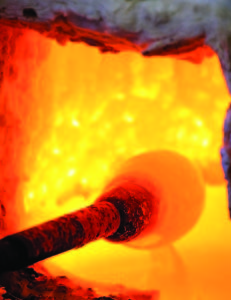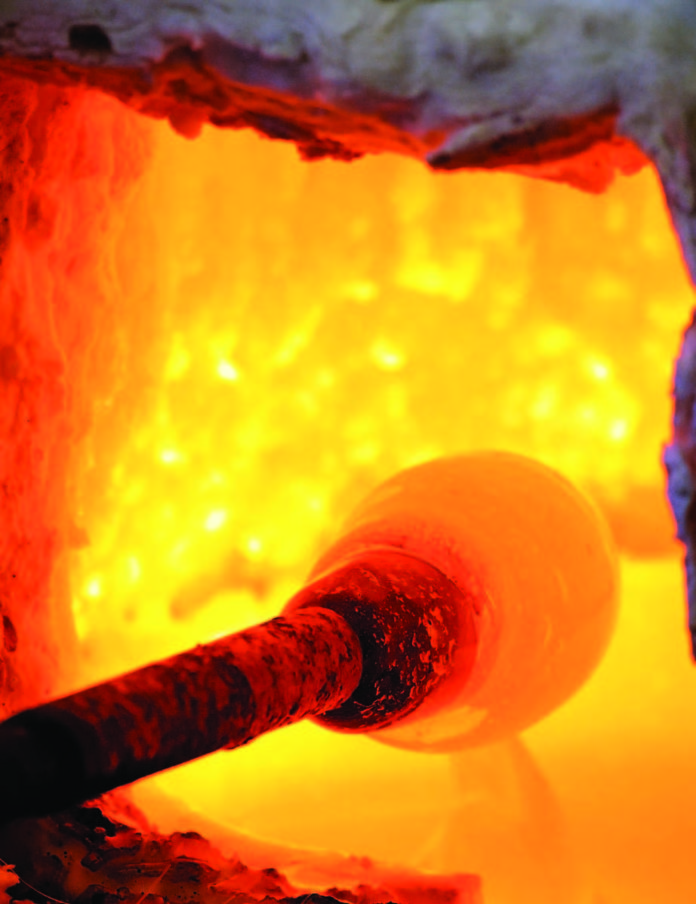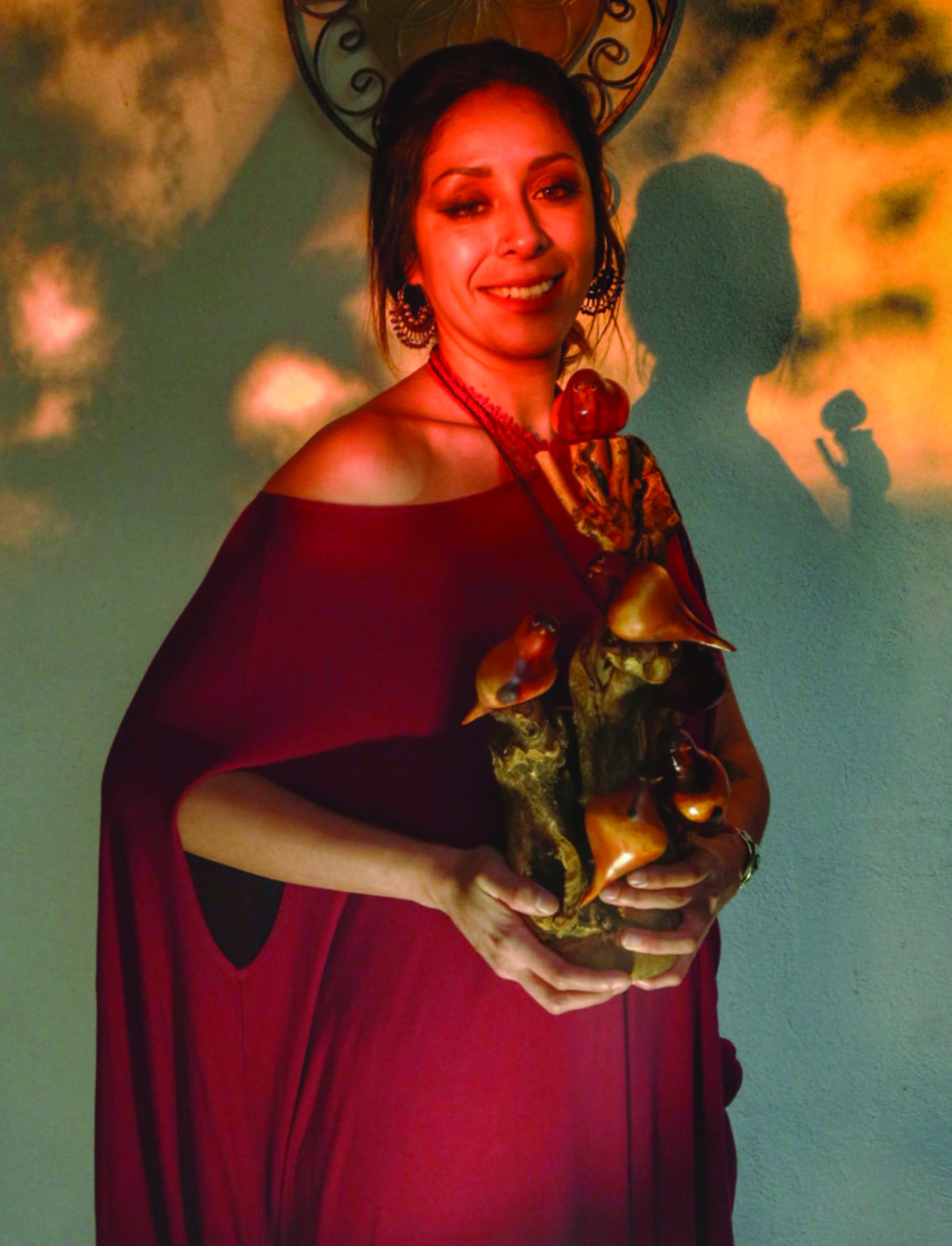
By Joseph Jaramillo
How does a water pipe or your favorite pipe get formed or an exquisite sculpture get made? This is done through the art of glassblowing. The practice involves shaping the material using heat and, as the term implies, blowing. It’s a relatively simple act that has the power to create aweinspiring art that can be functional, decorative, or both. The techniques used in glassblowing have remained nearly the same since it was first discovered. It involves molten glass, glass with the consistency of molasses that is gathered at the end of a hollow pipe. Air is then blown through that pipe and the pliable glass blooms into a bubble form. From there, it’s shaped by swinging, rolling, or blowing. Afterward, additional elements that would make the glass functional think handles or stems are attached using welding. Humans working with glass can be traced back to the prehistoric times of 4000 B.C.E. Men had not discovered glass blowing at that time, but they did take advantage of the natural glass called obsidian that was the result of volcanic eruptions. The hardened material was used in making tools, arrowheads, and amulets. At this time, humans also figured out the recipe for glass: sand, plant ash, and lime. The plant ash helped the sand to melt and the lime was a stabilizer that protected the material from moisture.
By 1500 BCE, people in Mesopotamia and Egypt shaped their own vessels by forming hot glass around solid cores and dung. After the glass cooled, the cores were removed to reveal a hollow form. In addition to making bowls, glass tiles were also created at this time.
We have the Syrian people to thank for the invention of the blowpipe. Around 300 BCE, they created the tool for which modern glassblowing is built upon. It caught on with the rest of the Roman Empire and they began experimenting with the practice by inventing new shapes and forms. The artisans also improved upon the basic glass formula to create designs within the material and decorate it using metal inlays.
The best glassblowers were in the Middle East and their secrets for how they produced glass were heavily guarded. During the Middle Ages, however, Italy—specifically Venice—became the mecca for glassblowing as the process was revealed through trade between the two places. The Italian government then forced all of the glassblowers to Murano island around 1300 CE. There, they perfected their craft and developed cristalo, a clear glass. They also produced new colors.
It was a huge risk for glass blowers to leave Murano—the act was punishable by death. But many succeeded in escaping and took their techniques to other parts of Europe and Asia. The Renaissance is when glassblowing became more widespread and was developed throughout Europe. In the 17th century, you could get a textbook on the subject called Arte Vetraria or The Art of Glass. During this time, more practical uses of glass began to emerge that still exist today, like window panes and glass watwrpipes. Art Nouveau, the artistic movement that was popular at the end of the 17th century and into the 18th century, was where we saw the development of art and mass fabrication. Louis Comfort Tiffany was working during this time and designing glass and stained iconic and more. The middle of the 20th century saw the rise of glass studios and artists who were working independently of large factories to produce their own creative pieces. In doing so, the techniques and approaches used in glassblowing have been both refined and new ones invented. Humans have used color to express ideas and emotion for thousands of years, even the most subtle nuances in color can result in shades that excite or calm, pacify or energize, and even suggest strength or vulnerability. “They can nurture you with their warmth, soothe you with their quiet coolness, and heighten your awareness of the world around you. Color enriches our universe and our perception of it. We all respond to color at a very visceral level, associating specific hues with another time or place. “Color invariably conveys moods that attach themselves to human feelings or reactions. Part of our psychic development, color is tied to our emotions as well as our intellect. Every color has meaning that we either inherently sense or have learned by association and/or conditioning, which enables us to recognize the messages and meanings delivered.”
It’s with all this in mind that she and a team of experts choose the Pantone Color of the Year, which the institute has named annually for more than two decades, gaining more attention and having more impact with each passing declaration. So this year, expect to see a lot of blue. The 2020 Pantone Color of the Year is known as Classic Blue.
Describing the shade as “evocative of the nighttime sky. We are living in a time that requires trust and faith It is this kind of constancy and confidence that is expressed by Classic Blue, a solid and dependable blue hue we can always rely on.” Classic Blue encourages us to look beyond the obvious, expand our thinking, open the flow of communication. which says that a good part of the emotions that colors evoke is tied to natural phenomena. Classic Blue is the color of outer space (look beyond), of the celestial sky (look beyond), of the deep ocean (open the flow). One of the earliest formal explorations of color theory came from German poet and politician Johann Wolfgang von Goethe. His 1820 book Theory of Colours explored the psychological impact of colors on mood and emotion. Yellow, Goethe wrote, is the color nearest the light, yet when applied to dull, coarse surfaces, it is no longer filled with its signature energy. “By a slight and scarcely perceptible change, the beautiful impression of fire and gold is transformed into one not undeserving the epithet foul; and the colour of honour and joy reversed to that of ignominy and aversion.” Of red: “All that we have said of yellow is applicable here, in a higher degree.” Goethe’s theories continue to intrigue, possibly because of the lyrical prose rather than its scientific facts. Today, it’s generally accepted that shades of blue are associated with steady dependability, calm, and serenity. Yellow evokes the color of the sun, associated with warmth and joy. Green connects with nature, health, and revival. White stands for simplicity; black for sophistication. A 1970s study on the body’s physiological responses to colors revealed that warm hues (red, orange, yellow—the colors of the sun) aroused people troubled with depression and increased muscle tone or blood pressure in hypertensive folks. Cool colors (green, blue, violet) elicited the reverse, but the important finding was that all colors produced clinically tangible results.
It’s not woo-woo science; humans have been using color as medicine, a practice known as chromotherapy, since ancient Egypt. In fact, chromotherapy is as tested a practice as any other alternative medicine— Ayurveda, acupuncture, homeopathy, aromatherapy, reflexology. While it is widely accepted that color affects one’s health—physically, mentally, emotionally— more studies are needed to determine the full scope of impact as well as its potential to help heal.
This isn’t a new theory, either. In the late 1800s, rays of color/light were shown to affect the blood stream. Later research found color to be “a complete therapeutic system for 123 major illnesses.
Today, bright white, full-spectrum light is being used in the treatment of cancers, seasonal affective disorder, anorexia, bulimia, insomnia, jet lag, alcohol and drug addiction, and more. Blue light is used to help treat rheumatoid arthritis. Red light helps with cancer and constipation. And that’s just the beginning. When your physical landscape is devoid of bright, vibrant hues, your emotional one is affected as well. That’s where color therapy comes in. It has a deep effect on physical, psychological, and emotional aspects of our lives, and it comes in many forms: light sessions that include color wheels. Colored crystal lights. Breathing in colors through meditation. Infrared saunas with chromotherapy add-ons
There are actually many ways of adjusting the color in your life, and not all of them require a trip to see a specialist. Unlike trying to self-administer acupuncture (don’t do that), techniques can be as simple as putting on colorful attire or getting some bright throw pillows or plants. You can never have too many plants. And you should eat more plants, too, filling your plate with healthful fruits, vegetables, cannabis and spices from every part of the spectrum. If a lack of sunlight has you feeling a lack of joy, paint your home or office— warm, vibrant yellows and oranges showcase excitement and warmth; browns and neutrals decidedly do not. Choose wisely. Painting not an option? Consider temporary wallpaper or hanging large artworks. On a budget? Head to the thrift shop and repurpose an old canvas by painting it white and then adding whatever hues you are vibing with this winter. If it doesn’t turn out well, cover it up with more white paint and start again. There are also an array of therapeutic options popping up as add-ons, as wellness studios, spas, and alternative medicine practices incorporate chromotherapy treatments into their offerings. Many infrared saunas are starting to offer chromotherapy benefits, and the combination of the full-light spectrum and the heat effectively tricks the brain into thinking it spent a full day basking in the sun, causing it to release those sweet endorphins that flood your body when the warm rays of spring hit your face when you step outside. It feels good and really, that is everything. Color is everything. There is a reason why we reach for that favorite pipe or water pipe it calls out to our soul.
Writing by Joseph Jaramillo


















